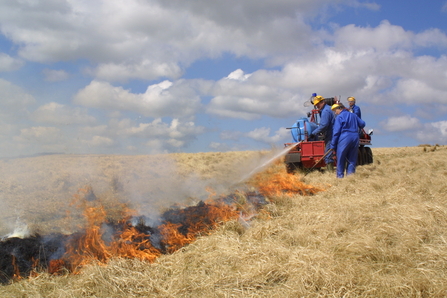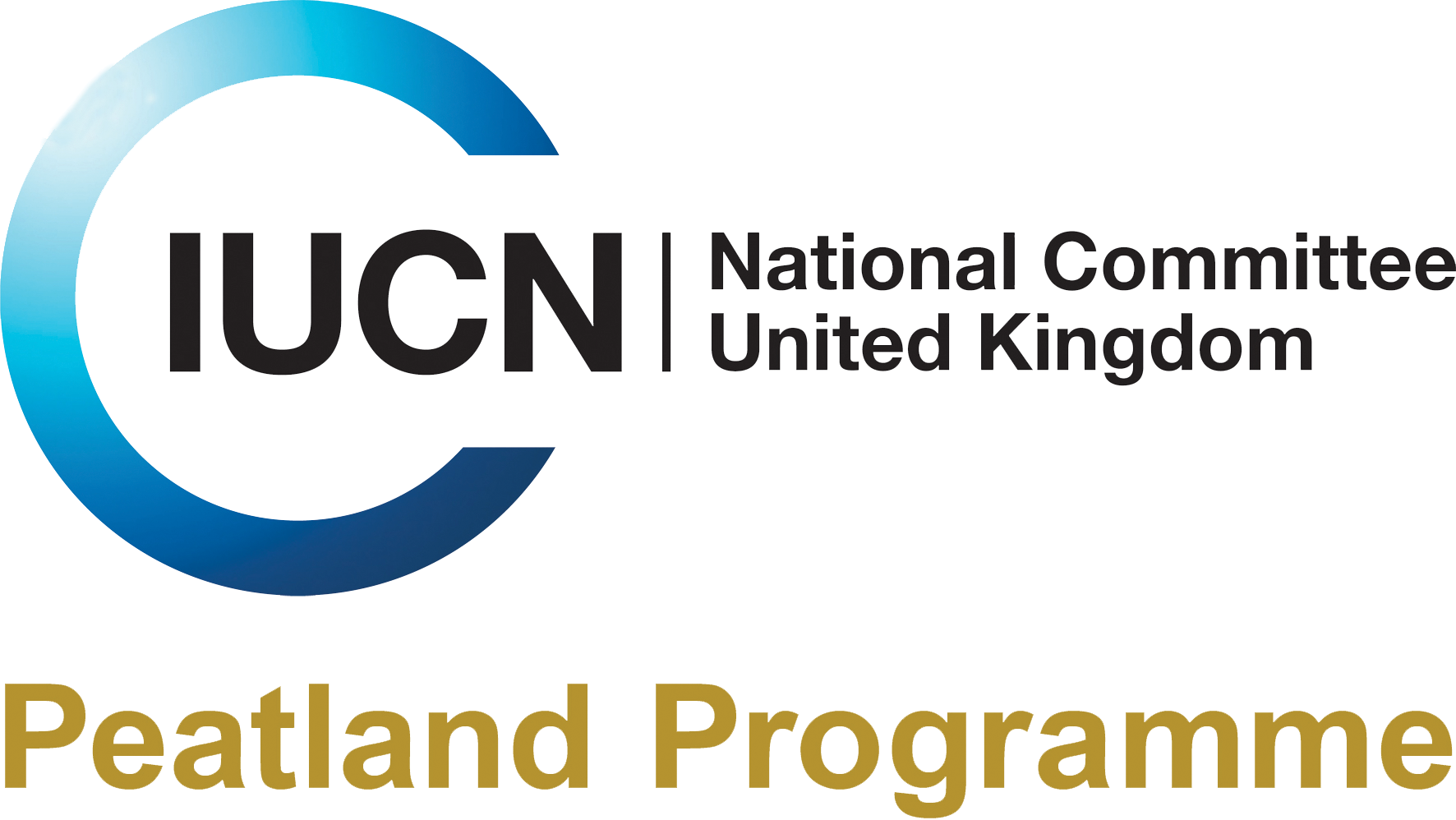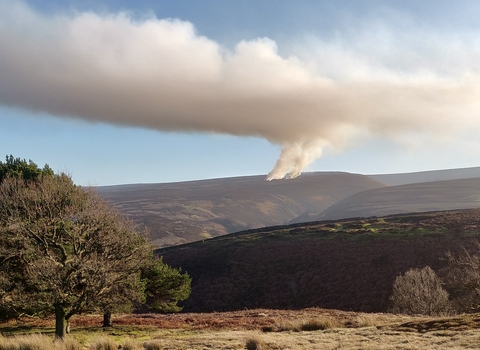It is the position of the IUCN UK Peatland Programme that burning does not constitute sustainable management of peatlands. The overwhelming scientific evidence base points to burning on peatlands causing damage to key peatland species, peatland ecosystem health, and the sustainability of peatland soils. We review emerging studies regularly to ensure that this remains in line with the best available evidence.
Why burn?
Burning as a land management tool has been practiced for long periods of time in the UK – but the reasons and methods have altered over time. It is practiced across a range of habitats, but in the UK, it is most extensively undertaken on upland ‘moorland’ sites to encourage or control different vegetation types. It has some different names colloquially across the UK; for example, on Dartmoor and Exmoor it is known as ‘swaling’, and may include gorse and grasses, while in Scotland it is called ‘muirburn’. Previously, burning was used in lowland areas to remove agricultural stubble in the post-harvest period, but this was effectively banned in 1993 due to concerns around atmospheric pollution.
There are two main reasons that burning is currently used on peatlands. Most commonly it is to produce heather stands of different ages for increasing grouse numbers for recreational shooting (using prescribed, rotational burning of patches of land), while to a lesser extent it is used for improving grazing for livestock. Burning has been undertaken on all moorland habitats, but perhaps the most contentious burning has been on sites where there is deep peat present.

Muirburn in the Cairngorms National Park. Credit: Badenoch and Strathspey conservation group

Swaling on Long Holcolmbe, Exmoor National Park. Credit: Heather Lowther
Moorland
‘Moorland’ as a word is not without controversy in ecological circles. It is best described as a colloquial term for a mosaic of diverse open upland habitats. Broadly speaking, moorland is the open area (in England, these are often the ancient common areas) found above the ‘fell line’ of the last walls which would have served to delineate the nutrient-rich hay meadows and pastures from the poorer grazing areas dominated by heathlands, bogs and acid grasslands.
Whilst each moorland will be different, the following habitats commonly make-up the mosaic: blanket bog, acid grassland, wet and dry heath (including sub-alpine and sub-arctic dwarf shrub heath), alkaline fen (which may have associated habitats such as spring head rill and flush, and soakaway and sump) and juniper heath.
The highest altitude areas (such as those found in the Cairngorms of Scotland) may exhibit transitional habitats between moorland and montane habitats. Some of plant species found within moorland areas are ‘fire-adapted’, such as common heather (Calluna vulgaris) and cloudberry (Rubus chamaemorus). Some, however, are highly sensitive and easily impacted by burning, such as the bog mosses (Sphagnum species), juniper (Juniperus communis) and cottongrasses (Eriophorum species).
Prescribed burning on peatlands
Burning on deep peat sites has been associated with a range of documented effects (see video below), and whilst there are some studies which suggest benefits, the majority of research shows that there are significant negative impacts. The impacts are wide ranging, from loss of vegetation communities and changes in the associated fauna, run-off with increased dissolved and particulate organic carbon, loss of sequestered soil carbon, increases in erosion rates due to exposure of the peat surface and increased atmospheric pollution from smoke1,2. While debate continues around some of the impacts or the extent to which they occur, the evidence against burning has been significant enough for the UK government to introduce legislation to restrict burning in England and Scotland.
Burning on blanket bogs (https://www.youtube.com/watch?v=nzsr5A4VhZU)
Animation looking at the effects of burning on blanket bogs. Credit: Richard Lindsay.
Regulation of burning
Legislation to restrict burning in England was introduced in 2021: the Westminster government enacted a ban on burning on deep peat areas (>40cm peat depth) within protected areas. The Scottish government introduced a broader ban on burning of all deep peat (>40cm) areas across Scotland. There are exceptions to both bans, however. In England burning may take place where there is a provable conservation benefit, while in Scotland it may be utilised as a management tool where there is a wildfire risk, or for the purposes of research.
‘Deep peat’ refers to the depth at which a site is considered to be blanket bog for the purposes of burning legislation (burning is rarely undertaken on fen peats), but like the term moorland, it is controversial. Deep peat is an arbitrary definition that was developed in response to a desire to exploit peatlands for agriculture in the post-war period. A depth-based definition of peatlands, whilst useful in protecting the larger carbon stock of deeper peat soils, does not reduce the risk to wider habitat conservation and biodiversity objectives, or offer protection to the other ecosystem services that healthy, un-burned peatlands provide.
Wildfire
There has been a lot of discussion recently about the role of burning in managing wildfires. At present there is no experimental field data available specifically from peatland contexts to support the notion that burning is an effective long-term control mechanism against wildfires. Evidence on the use of burning for wildfire management is currently derived from studies of arid ecosystems which are not comparable to peatlands. Where studies have considered the use of burning on peatlands, it has been for the limiting of paludification (peat growth) to encourage conditions for tree growth3,4.
Our current view is that rewetting should be the primary tool used to improve peatland health and to limit the spread of wildfire. Common heather is a fire adapted species which prefers drier soils. Burning therefore promotes drier ground and greater heather growth. Rewetting conversely limits heather growth, removing the burn-regrowth cycle which can ultimately increase wildfire risk. We acknowledge that there may be areas where wildfire risks are greater – such as those close to popular tourist spots – that may need interim management measures to mitigate these risks. We also acknowledge that further research needs to be conducted to understand the period of risk posed by a legacy of drier vegetation on degraded peatlands that are under restoration or recovery.
References
- Yallop AR, Clutterbuck B. Land management as a factor controlling dissolved organic carbon release from upland peat soils 1: Spatial variation in DOC productivity. Science of The Total Environment. 2009 Jun;407(12):3803–13. https://doi.org/10.1016/j.scitotenv.2009.03.012.
- Graham AM, Pope RJ, McQuaid JB, Pringle KP, Arnold SR, Bruno AG, et al. Impact of the June 2018 Saddleworth Moor wildfires on air quality in northern England. Environmental Research Communications. 2020 Mar 13;2(3):031001. https://iopscience.iop.org/article/10.1088/2515-7620/ab7b92
- Lavoie M, Paré D, Fenton N, Groot A, Taylor K. Paludification and management of forested peatlands in Canada: a literature review. Environmental Reviews. 2005 Jun 1;13(2):21–50. https://doi.org/10.1139/a05-006.
- Renard SM, Gauthier S, Fenton NJ, Lafleur B, Bergeron Y. Prescribed burning after clearcut limits paludification in black spruce boreal forest. Forest Ecology and Management. 2016 Jan;359:147–55. https://doi.org/10.1016/j.foreco.2015.09.037.

